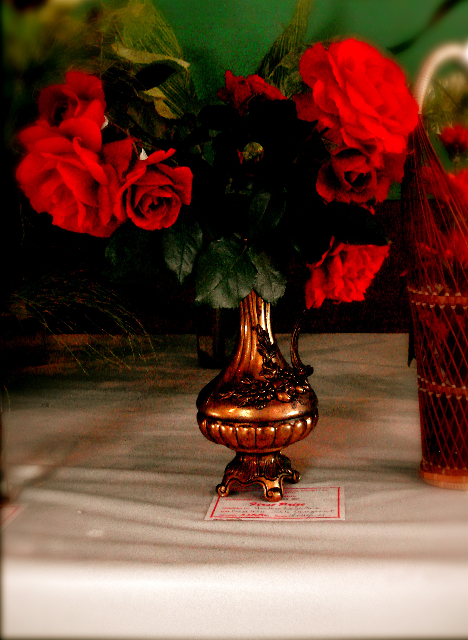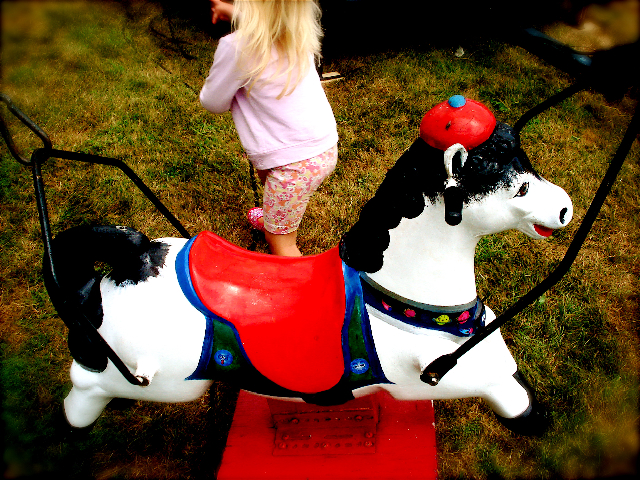The scent of the show
Novelist Kelly Ana Morey searches for the classic battered hot dog at the Warkworth A & P Show and recalls her pony eventing past. Photographs by Kelly Ana Morey.

The smell should be the giveaway as I drive into the Warkworth A&P Society show-grounds just north of town. The base elements—animal excrement, cooking meat, sugar and hard dusty ground—are all there, but something is missing from this complex alchemy which has the power to instantly take me back to my childhood summers.
Even though I grew up in Papua New Guinea, the family always returned home to New Zealand for annual leave at Christmas time to a little hamlet called Kaingaroa, a dozen or so kilometres south of Kaitaia on State Highway 16, where one of my grandmothers lived. Mum had this great friend, Jean West, who always provided me with a pony to ride for the duration of our stay. The highlight was going to the Mangonui and Broadwood A&P shows on whichever pony, usually a little chestnut mare called Gaytime, I got to call my own for eight weeks.
I can’t say I did particularly well at these events, real life not following the same lines as my beloved pony novels, where a good heart was always the winner by the conclusion. I do, however, have a distinct memory of being very proud of a handful of ribbons—okay, four—I managed to win over the course of a few summer holidays. One, I remember, was a second in the trotting race, because Gaytime was a legendary trotter. I knew this because Jean told me so a lot.
Because going to the show was an occasion of extreme high excitement I, like I suspect every other little girl also competing on her pony, would never have time to eat. By mid-afternoon with classes all but wrapped up and only the championships to be decided, I would discover that I was ravenously hungry. Clutching a brown one dollar bill, the paper edges foxed with use, I would go to the great long white caravans—there were usually two or three scattered around the show grounds—which were manned by a chorus line of rough tattooed men and tired-looking women who cooked hot dogs and chips for hour after hour as the sun beat down on the tin roofs of their prisons.
‘Here you go, luv,’ one of the servers would say, leaning out over the counter to hand the hot dog on a stick down to me. ‘You be careful now, it’s hot.’ The end would be dipped in a thick, sweet tomato sauce that I now know must be a particular catering brand that they all used. It tasted nothing like Wattie's tomato sauce, but somehow it was, and still is, the perfect tomato sauce for a battered and deep-fried sausage. Too hungry to wait for what amounted to both my breakfast and lunch to cool before eating, I would impatiently strip the batter from the grey sausage, stuffing it in my mouth. And it was always the best thing I had eaten in forever.
Thirty-odd years later it isn’t until I’m wandering the trade stands, peering hopefully at catering caravans looking for the ubiquitous show hot dog on a stick, that the realisation dawns that the key note that says eau de A&P show like no other, the distinctive aroma of lard bubbling away in the deep fryers, is almost completely absent from the grounds. With no sign of a catering van bearing the appropriate signage, nor individuals wandering around eating anything even remotely resembling the culinary delight I crave, my worst suspicions are confirmed. There are NO hot dogs … well none of the Kiwi variety, battered, sticked and sauce-dipped, anyway. There are “American” hot dogs which bear no resemblance to anything I’ve ever eaten off a stand in New York; the sausage is a gourmet venison and the bun is toasted, which is just wrong.
Now, the absence of heart disease on a stick shouldn’t really matter, there’s food galore including two crepe makers and sushi, but for days I’ve been thinking obsessively about eating an A&P show hot dog. It has been years since I have eaten one and I must confess it was the thing I was most looking forward to.
I’m not happy about this state of affairs, but I am here on a mission other than to feed myself with cholesterol-saturated food. There’s much to see and photograph. First stop, the indoor exhibits which I have high hopes for photographically. Visions of gigantic six-egg sponges, pink and baby-blue lamingtons and perfectly iced neenish tarts have haunted me in the days leading up to the show—you would think I would have learned by now that things don’t always look the way you want them to. I eventually locate the shed housing these particular exhibits that, in days of old, were a way in which country women squared off against each other and showed their skills in the domestic arts: knitting and sewing, cooking and flower arranging. The men, though mostly involved in outdoor exhibiting of animals, had their own small role to play indoors in terms of the fruit and vegetables they grew in the family garden. Of course women don’t have time to do these things anymore. They work as well as raise families and keep house, little wonder that we let Craig’s make our jams.
Disappointingly, the vegetables are wilting, the baking is practically non-existent and unappetising, and strangely enough most of the exhibits are caged behind chicken wire screens to prevent, I assume, theft. The effect is curiously museum-like until I get to a clutch of dolls from the 60s who are modelling the knitwear. Behind their wire screen with the institutional green wall backdrop I am immediately reminded of children living in cages in orphanages in Romania under Nicolae Ceausescu’s regime. As if dolls aren’t creepy enough.
Cutting across the grounds towards the pony ring, I skirt around a Highland band, members of whom are also providing accompaniment for the Irish dancing competitions—dance knowing no cultural boundaries, obviously. Good Irish dancing is riveting for about two minutes, inept Irish dancing runs out of credit with me in about a quarter of that time. It’s the grim expressions on the competitors faces, they don’t look like they’re having any fun at all, not like the junior show princess competition. Now those little girls are having a ball. There’s tulle and sequins and ruffles and ruching, tiaras and shiny polyester by a veritable country mile, and everyone gets a prize, so what’s not to love.
I grab an organic strawberry yoghurt ice-cream from a kiosk, which is probably better for me than a hot dog anyway and admittedly really tasty, but not quite the same. Nevertheless, things change, even venerable institutions like A&P shows. The trick, I decide, is to roll with it. I sit under a tree and watch the last of the saddle pony classes. As is always the way, the sidelines are littered with parents/judges muttering away about who’s winning and who’s not. The kids are always much better behaved at these events than their parents. To be fair, with no vested interest whatsoever and a rather good eye for horse-flesh, I think the judge has got it wrong to with the large pony (13.2hh-14.2hh) reserve championship. The brown pony he selects, though very pretty, is a bit flat and quick across the ground and has a massive growth on its neck!
My pick is an old hand, a grey that has turned completely white with age, who admittedly has done this so many times before that she refuses to move with any more energy than is necessarily required. But the pony is nicely put together and has lovely if slightly reluctant movement. In addition its snowy hide, which bears testament to much shampooing, is utterly free of hideous growths and the pony has a luxuriant waterfall of a tail which I covet for my own meagre-tailed mount lurking in a paddock at home. There are also two young ponies—a rich golden dun and a lovely steel-grey—who have also qualified through to the championship round, though not going as nicely as the seasoned ponies that are actually the pick of the group. They’re both being ridden in plain snaffles and though a little tense are focused on the job. A couple more shows and they’ll be the ones getting those big championship sashes, trust me. One day, definitely, I’m going to breed a couple of show ponies.
Leaving the show grounds I spot a kid with a hot dog—bloody typical!

Kelly Ana Morey is something of a dilettante: a historian who writes, literary novels mostly, but has forayed into social history, poetry, art theory, journalism, art and literary criticism, copy writing and the devilishly difficult genre of the short story. She's fairly nifty with a camera too. To even out the ups and downs of literary life she has also, at last, gone back to university and in four years will be Dr Kel, which sounds like the punchline of a moderately funny joke.